
Water hardness edta
- 1. CHM 101/102 Water Hardness: Determination with EDTA • Purpose To determine the “hardness” of a water sample using an EDTA titration. To learn and practice quantitative techniques for determining the concentrations of solutions. • Safety Considerations Keep the pH 10 buffer in the hood. Avoid breathing ammonia vapors from the buffer. Eriochrome Black T will stain skin and clothes. All waste materials can be safely rinsed down the sink. Laboratory Manual
- 2. CHM 101/102 Water Hardness: Determination with EDTA Water is said to be “hard” when it contains Ca2+ and Mg2+ ions. These ions react with soap to form an insoluble substance called “soap scum”. Ca2+ and Mg2+ ions along with other metal ions such as Fe3+ and Pb2+ can be removed from hard water by the addition of EDTA (ethylenediaminetetraacetic acid). EDTA has a greater affinity for Ca2+ and Mg2+ when it is in the form of the dihydrogen anion H2EDTA2-. This is the ionic form of EDTA at pH 10. H2EDTA2- dihydrogen ethylenediaminetetraacetate ion Laboratory Manual
- 3. CHM 101/102 Water Hardness: Determination with EDTA H2EDTA2- binds to a Ca2+ ion by forming four special covalent bonds called coordinate covalent bonds. + + 2 H+ Ca2+ H2EDTA2- Ca2+ ion chelated by EDTA In today’s experiment, you will determine the total concentration of calcium and magnesium ions in a hard water sample using EDTA in a solution buffered to a pH of 10. Laboratory Manual
- 4. CHM 101/102 Water Hardness: Determination with EDTA • Using a Volumetric Pipet Squeeze the pipet bulb and place the silicone end over the top of the pipet. Do not force the pipet into the bulb. Draw liquid up into the pipet until it is just above the calibration mark. Slide the bulb off the pipet and place your index finger over the top of the pipet. Laboratory Manual
- 5. CHM 101/102 Water Hardness: Determination with EDTA Carefully release liquid from the pipet until the bottom of the meniscus is on the calibration line. Release your finger and allow the liquid in the pipet to drain into a beaker or flask. Touch the tip of the pipet to the side of the beaker or flask to completely drain the pipet. Laboratory Manual
- 6. CHM 101/102 Water Hardness: Determination with EDTA • Using a Buret Clean the buret with a buret brush, water, and a small amount of detergent. Rinse it twice with deionized water. Be sure to drain deionized water through the tip. Rinse the buret again with two 10 mL portions of the titrant (EDTA in this experiment). Fill the buret with titrant and drain a small amount from the buret to dispel any air bubbles that might be remove in the tip. air bubble Laboratory Manual
- 7. CHM 101/102 Water Hardness: Determination with EDTA Use a marker pen to create a black area on a white note card. This will be used to help locate the bottom of the meniscus when reading the buret. Place the notecard with the black mark behind the buret and just below the meniscus. This will make the bottom of the meniscus much easier to see. Record the volume reading to the nearest 0.01 mL. Laboratory Manual
- 8. CHM 101/102 Water Hardness: Determination with EDTA If you need to dispense less than a full drop of titrant, open the stopcock slightly to allow a small amount of titrant to accumulate on the tip of the buret. Rinse the titrant on the tip into the flask using deionized water from your wash bottle. Laboratory Manual
- 9. CHM 101/102 Water Hardness: Determination with EDTA • Procedure (Titration of Blank) Use a volumetric pipet to dispense 25.00 mL of deionized water (DI) into a 250 mL flask. Add 5 mL of pH 10 buffer, 2 drops of Eriochrome Black T indicator, and 15 drops of 0.03 M MgCl2. Titrate the solution with EDTA from your buret. As you near the endpoint, the solution will turn purple. Continue to slowly add EDTA until the solution turns blue, with no trace of red. beginning nearing endpoint color endpoint color Laboratory Manual
- 10. CHM 101/102 Water Hardness: Determination with EDTA • Procedure (Titrating Blank and Sample) The following video clip demonstrates the proper technique for titrating both the sample and the blank. Laboratory Manual
- 11. CHM 101/102 Water Hardness: Determination with EDTA • Procedure (Titration of Sample) Use a volumetric pipet to dispense 50.00 mL of your hard water sample into a 250 mL flask. Add 5 mL of pH 10 buffer, 2 drops of Eriochrome Black T indicator, and 15 drops of 0.03 M MgCl2. Titrate the solution with EDTA from your buret to the blue endpoint you observed when titrating the blank. endpoint color Laboratory Manual
- 12. CHM 101/102 Water Hardness: Determination with EDTA • Calculations 1 mol CaCO3 (1) mol CaCO3 in sample = LEDTA x MEDTA x 1 mol EDTA moles CaCO3 (2) MCaCO3 = 50 x 10-3 L sample 100 g CaCO3 1000 mg (3) mg/L CaCO3 = MCaCO3 x x 1 mol CaCO3 1g (4) ppm = mg/L Laboratory Manual